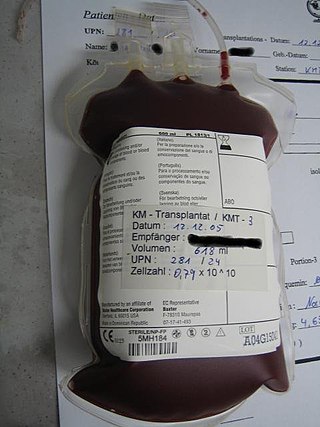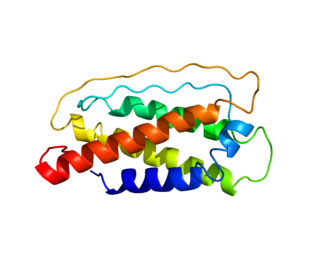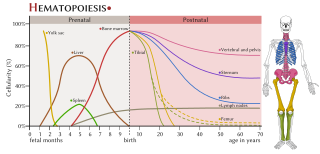Related Research Articles

T cells are one of the important types of white blood cells of the immune system and play a central role in the adaptive immune response. T cells can be distinguished from other lymphocytes by the presence of a T-cell receptor (TCR) on their cell surface.
Aplastic anemia (AA) is a severe hematologic condition in which the body fails to make blood cells in sufficient numbers. Aplastic anemia is associated with cancer and various cancer syndromes. Blood cells are produced in the bone marrow by stem cells that reside there. Aplastic anemia causes a deficiency of all blood cell types: red blood cells, white blood cells, and platelets.

Hematopoietic stem-cell transplantation (HSCT) is the transplantation of multipotent hematopoietic stem cells, usually derived from bone marrow, peripheral blood, or umbilical cord blood in order to replicate inside of a patient and to produce additional normal blood cells. It may be autologous, allogeneic or syngeneic.

Graft-versus-host disease (GvHD) is a syndrome, characterized by inflammation in different organs. GvHD is commonly associated with bone marrow transplants and stem cell transplants.

Hematopoietic stem cells (HSCs) are the stem cells that give rise to other blood cells. This process is called haematopoiesis. In vertebrates, the very first definitive HSCs arise from the ventral endothelial wall of the embryonic aorta within the (midgestational) aorta-gonad-mesonephros region, through a process known as endothelial-to-hematopoietic transition. In adults, haematopoiesis occurs in the red bone marrow, in the core of most bones. The red bone marrow is derived from the layer of the embryo called the mesoderm.

Cell therapy is a therapy in which viable cells are injected, grafted or implanted into a patient in order to effectuate a medicinal effect, for example, by transplanting T-cells capable of fighting cancer cells via cell-mediated immunity in the course of immunotherapy, or grafting stem cells to regenerate diseased tissues.

Interleukin 7 (IL-7) is a protein that in humans is encoded by the IL7 gene.
Primary immunodeficiencies are disorders in which part of the body's immune system is missing or does not function normally. To be considered a primary immunodeficiency (PID), the immune deficiency must be inborn, not caused by secondary factors such as other disease, drug treatment, or environmental exposure to toxins. Most primary immunodeficiencies are genetic disorders; the majority are diagnosed in children under the age of one, although milder forms may not be recognized until adulthood. While there are over 430 recognized inborn errors of immunity (IEIs) as of 2019, the vast majority of which are PIDs, most are very rare. About 1 in 500 people in the United States are born with a primary immunodeficiency. Immune deficiencies can result in persistent or recurring infections, auto-inflammatory disorders, tumors, and disorders of various organs. There are currently limited treatments available for these conditions; most are specific to a particular type of PID. Research is currently evaluating the use of stem cell transplants (HSCT) and experimental gene therapies as avenues for treatment in limited subsets of PIDs.

Minor histocompatibility antigen are peptides presented on the cellular surface of donated organs that are known to give an immunological response in some organ transplants. They cause problems of rejection less frequently than those of the major histocompatibility complex (MHC). Minor histocompatibility antigens (MiHAs) are diverse, short segments of proteins and are referred to as peptides. These peptides are normally around 9-12 amino acids in length and are bound to both the major histocompatibility complex (MHC) class I and class II proteins. Peptide sequences can differ among individuals and these differences arise from SNPs in the coding region of genes, gene deletions, frameshift mutations, or insertions. About a third of the characterized MiHAs come from the Y chromosome. Prior to becoming a short peptide sequence, the proteins expressed by these polymorphic or diverse genes need to be digested in the proteasome into shorter peptides. These endogenous or self peptides are then transported into the endoplasmic reticulum with a peptide transporter pump called TAP where they encounter and bind to the MHC class I molecule. This contrasts with MHC class II molecules's antigens which are peptides derived from phagocytosis/endocytosis and molecular degradation of non-self entities' proteins, usually by antigen-presenting cells. MiHA antigens are either ubiquitously expressed in most tissue like skin and intestines or restrictively expressed in the immune cells.

HIV/AIDS research includes all medical research that attempts to prevent, treat, or cure HIV/AIDS, as well as fundamental research about the nature of HIV as an infectious agent and AIDS as the disease caused by HIV.
Graft-versus-tumor effect (GvT) appears after allogeneic hematopoietic stem cell transplantation (HSCT). The graft contains donor T cells that can be beneficial for the recipient by eliminating residual malignant cells. GvT might develop after recognizing tumor-specific or recipient-specific alloantigens. It could lead to remission or immune control of hematologic malignancies. This effect applies in myeloma and lymphoid leukemias, lymphoma, multiple myeloma and possibly breast cancer. It is closely linked with graft-versus-host disease (GvHD), as the underlying principle of alloimmunity is the same. CD4+CD25+ regulatory T cells (Treg) can be used to suppress GvHD without loss of beneficial GvT effect. The biology of GvT response is still not fully understood but it is probable that the reaction with polymorphic minor histocompatibility antigens expressed either specifically on hematopoietic cells or more widely on a number of tissue cells or tumor-associated antigens is involved. This response is mediated largely by cytotoxic T lymphocytes (CTL) but it can be employed by natural killers as separate effectors, particularly in T-cell-depleted HLA-haploidentical HSCT.

The haematopoietic system is the system in the body involved in the creation of the cells of blood.
Marcel R.M. van den Brink is a Dutch oncologist and researcher at Memorial Sloan Kettering Cancer Center known for his research in hematopoietic stem cell transplantation for cancer patients.
Microtransplantation (MST) is an advanced technology to treat malignant hematological diseases and tumors by infusing patients with granulocyte colony-stimulating factor (G-CSF) mobilized human leukocyte antigen (HLA)-mismatched allogeneic peripheral blood stem cells following a reduced-intensity chemotherapy or targeted therapy. The term "microtransplantation" comes from its mechanism of reaching donor cell microchimerism.
Guo Mei is a hematologist and associate director of 307th Hospital of Chinese People’s Liberation Army and deputy director of Radiation Research Institute.
Thymoglobulin is an anti-human thymocyte immunoglobulin preparation made of purified polyclonal antibodies derived from rabbits. While these antibodies have a variety of specificities, their main mechanism of immunosuppression is through depletion of T cells. Thymoglobulin is currently approved for clinical use in Europe and the United States for renal allograft rejection, prevention of graft-vs.-host disease, and conditions involving bone marrow failure, including aplastic anemia and has additional off-label uses.
In the immune system, veto cells are white blood cells that have a selective immunomodulation properties. Veto cells were first described in 1979 as cells that “can prevent generation of cytotoxic lymphocytes by normal spleen cells against self-antigens”. Hence, veto cells delete T cells that recognize the veto cells.

Shimon Slavin is an Israeli professor of medicine. Slavin pioneered the use of immunotherapy mediated by allogeneic donor lymphocytes and innovative methods for stem cell transplantation for the cure of hematological malignancies and solid tumors, and using hematopoietic stem cells for induction of transplantation tolerance to bone marrow and donor allografts.
Maria Grazia Roncarolo is an Italian pediatrician who is currently George D. Smith Professor in Stem Cell and Regenerative Medicine and Professor of Medicine at Stanford University. She is also the Director of the Stanford Institute of Stem Cell Biology and Regenerative Medicine along with Irving Weissman and Michael Longaker and the Director for Center for Definitive and Curative Medicine at Stanford.
A T memory stem cell (TSCM) is a type of long-lived memory T cell with the ability to reconstitute the full diversity of memory and effector T cell subpopulations as well as to maintain their own pool through self-renewal. TSCM represent an intermediate subset between naïve (Tn) and central memory (Tcm) T cells, expressing both naïve T cells markers, such as CD45RA+, CD45RO-, high levels of CD27, CD28, IL-7Rα (CD127), CD62L, and C-C chemokine receptor 7 (CCR7), as well as markers of memory T cells, such as CD95, CD122 (IL-2Rβ), CXCR3, LFA-1. These cells represent a small fraction of circulating T cells, approximately 2-3%. Like naïve T cells, TSCM cells are found more abundantly in lymph nodes than in the spleen or bone marrow; but in contrast to naïve T cells, TSCM cells are clonally expanded. Similarly to memory T cells, TSCM are able to rapidly proliferate and secrete pro-inflammatory cytokines in response to antigen re-exposure, but show higher proliferation potential compared with Tcm cells; their homeostatic turnover is also dependent on IL-7 and IL-15.
References
- ↑ UPHOFF, DE (March 1958). "Perclusion of secondary phase of irradiation syndrome by inoculation of fetal hematopoietic tissue following lethal total-body x-irradiation". Journal of the National Cancer Institute. 20 (3): 625–32. PMID 13539613.
- ↑ Reisner, Y; Kapoor, N; Kirkpatrick, D; Pollack, MS; Cunningham-Rundles, S; Dupont, B; Hodes, MZ; Good, RA; O'Reilly, RJ (February 1983). "Transplantation for severe combined immunodeficiency with HLA-A, B, D, DR incompatible parental marrow cells fractionated by soybean agglutinin and sheep red blood cells". Blood. 61 (2): 341–8. doi: 10.1182/blood.V61.2.341.341 . PMID 6217853.
- 1 2 3 Or-Geva, N; Reisner, Y (March 2016). "The evolution of T-cell depletion in haploidentical stem-cell transplantation". British Journal of Haematology. 172 (5): 667–84. doi: 10.1111/bjh.13868 . PMID 26684279.
- ↑ Daniele, Nicola; Scerpa, Maria; Caniglia, Maurizio; Ciammetti, Chiara; Rossi, Cecilia; Bernardo, Maria; Locatelli, Franco; Isacchi, Giancarlo; Zinno, Francesco (2012). "Overview of T-cell depletion in haploidentical stem cell transplantation". Blood Transfusion. 10 (3): 264–272. doi:10.2450/2012.0106-11. PMC 3417724 . PMID 22337272.
- ↑ Booth, Claire (2013). "The Current Role of T Cell Depletion in Paediatric Stem Cell Transplantation". British Journal of Haematology. 162 (2): 177–190. doi: 10.1111/bjh.12400 . PMID 23718232. S2CID 26726330.
- ↑ Devine, Steven; Carter, Shelly; Soiffer, Robert; Pasquini, Marcelo; Hari, Parameswaran; Stein, Anthony; Lazarus, Hillard; Linker, Charles; Stadtmauer, Edward; Alyea, Edwin; Keever-Taylor, Carolyn; O'Reilly, Richard (2012). "Low Risk of Chronic Graft Versus Host Disease and Relapse Associated with T-Cell Depleted Peripheral Blood Stem Cell Transplantation for Acute Myeloid Leukemia in First Remission: Results of the Blood and Marrow Transplant Clinical Trials Network (BMT CTN) Protocol 0303". Biology of Blood and Marrow Transplantation. 17 (9): 1343–1351. doi:10.1016/j.bbmt.2011.02.002. PMC 3150599 . PMID 21320619.
- 1 2 Antin, Joseph (2011). "T-Cell Depletion in GVHD: Less is More?". Blood. 117 (23): 6061–6062. doi: 10.1182/blood-2011-04-348409 . PMID 21659553.
- ↑ Aversa, F; Bachar-Lustig, E; Or-Geva, N; Prezioso, L; Bonomini, S; Manfra, I; Monti, A; Schifano, C; Zlotnikov-Klionsky, Y; Martelli, MF; Sammarelli, G; Sassi, M; Soli, M; Giuliodori, S; Benecchi, M; Giuliani, N; Lohr, F; Pratissoli, S; Reisner, Y (14 November 2017). "Immune tolerance induction by nonmyeloablative haploidentical HSCT combining T-cell depletion and posttransplant cyclophosphamide". Blood Advances. 1 (24): 2166–2175. doi:10.1182/bloodadvances.2017009423. PMC 5737124 . PMID 29296864.
- ↑ Marek, A; Stern, M; Ansari, M; Ozsahiri, H; Güngör, T; Gerber, B; Kühne, T; Passweg, JR; Gratwohl, A; Tichelli, A; Segger, R; Schanz, U; Halter, J; Stussi, G (2014). "The impact of T-cell depletion techniques on the outcome after haploidentical hematopoietic SCT". Bone Marrow Transplantation. 49 (1): 55–61. doi:10.1038/bmt.2013.132. PMID 24037023.
- ↑ Lang, P; Schumm, M; Greil, J; Bader, P; Klingebiel, T; Müller, I; Feuchtinger, T; Pfeiffer, M; Schlegel, PG; Niethammer, D; Handgretinger, R (2005). "A comparison between three graft manipulation methods for haploidentical stem cell transplantation in pediatric patients: preliminary results of a pilot study". Klinische Padiatrie. 217 (6): 334–8. doi:10.1055/s-2005-872529. PMID 16307419. S2CID 9698877.
- ↑ Airoldi, I; Bertaina, A; Prigione, I; Zorzoli, A; Pagliara, D; Cocco, C; Meazza, R; Loiacono, F; Lucarelli, B; Bernardo, ME; Barbarito, G; Pende, D; Moretta, A; Pistoia, V; Moretta, L; Locatelli, F (9 April 2015). "γδ T-cell reconstitution after HLA-haploidentical hematopoietic transplantation depleted of TCR-αβ+/CD19+ lymphocytes". Blood. 125 (15): 2349–58. doi:10.1182/blood-2014-09-599423. PMC 4440890 . PMID 25612623.
- ↑ Di Ianni, M; Falzetti, F; Carotti, A; Terenzi, A; Castellino, F; Bonifacio, E; Del Papa, B; Zei, T; Ostini, RI; Cecchini, D; Aloisi, T; Perruccio, K; Ruggeri, L; Balucani, C; Pierini, A; Sportoletti, P; Aristei, C; Falini, B; Reisner, Y; Velardi, A; Aversa, F; Martelli, MF (7 April 2011). "Tregs prevent GVHD and promote immune reconstitution in HLA-haploidentical transplantation". Blood. 117 (14): 3921–8. doi: 10.1182/blood-2010-10-311894 . PMID 21292771. S2CID 206896191.
- ↑ Or-Geva, N; Reisner, Y (August 2014). "Megadose stem cell administration as a route to mixed chimerism". Current Opinion in Organ Transplantation. 19 (4): 334–41. doi:10.1097/MOT.0000000000000095. PMID 24905022.
- ↑ Ophir, E; Or-Geva, N; Gurevich, I; Tal, O; Eidelstein, Y; Shezen, E; Margalit, R; Lask, A; Shakhar, G; Hagin, D; Bachar-Lustig, E; Reich-Zeliger, S; Beilhack, A; Negrin, R; Reisner, Y (14 February 2013). "Murine anti-third-party central-memory CD8(+) T cells promote hematopoietic chimerism under mild conditioning: lymph-node sequestration and deletion of anti-donor T cells". Blood. 121 (7): 1220–8. doi:10.1182/blood-2012-07-441493. PMC 4467899 . PMID 23223359.
- ↑ Or-Geva, N; Reisner, Y (2015). "Exercising 'veto' power to make haploidentical hematopoietic stem cell transplantation a safe modality for induction of immune tolerance". Regenerative Medicine. 10 (3): 239–42. doi:10.2217/rme.14.94. PMID 25933232.
- ↑ Lask, A; Ophir, E; Or-Geva, N; Cohen-Fredarow, A; Afik, R; Eidelstein, Y; Reich-Zeliger, S; Nathansohn, B; Edinger, M; Negrin, RS; Hagin, D; Reisner, Y (11 April 2013). "A new approach for eradication of residual lymphoma cells by host nonreactive anti-third-party central memory CD8 T cells". Blood. 121 (15): 3033–40. doi:10.1182/blood-2012-06-432443. PMC 4467889 . PMID 23446736.
- ↑ Nishimura, Yoshiaki; Brown, Charles R.; Mattapallil, Joseph J.; Igarashi, Tatsuhiko; Buckler-White, Alicia; Lafont, Bernard A. P.; Hirsch, Vanessa M.; Roederer, Mario; Martin, Malcolm A. (2005-05-31). "Resting naïve CD4+ T cells are massively infected and eliminated by X4-tropic simian–human immunodeficiency viruses in macaques". Proceedings of the National Academy of Sciences of the United States of America. 102 (22): 8000–8005. Bibcode:2005PNAS..102.8000N. doi: 10.1073/pnas.0503233102 . ISSN 0027-8424. PMC 1142395 . PMID 15911767.
- ↑ Cooper, Arik; García, Mayra; Petrovas, Constantinos; Yamamoto, Takuya; Koup, Richard A.; Nabel, Gary J. (2013-06-20). "HIV-1 causes CD4 cell death through DNA-dependent protein kinase during viral integration". Nature. 498 (7454): 376–379. Bibcode:2013Natur.498..376C. doi:10.1038/nature12274. ISSN 1476-4687. PMID 23739328. S2CID 4331149.
- ↑ Palmer, Clovis; Ostrowski, Matias; Gouillou, Maelenn; Tsai, Louis; Yu, Di; Zhou, Jinglin; Henstridge, Darren; Maisa, Anna; Hearps, Anna; Lewin, Sharon; Landay, Alan; Jaworowski, Anthony; McCune, Joseph; Crowe, Suzanne (2014). "Increased glucose metabolic activity is associated with CD4+ T-cell activation and depletion during chronic HIV infection". AIDS. 28 (3): 297–309. doi:10.1097/QAD.0000000000000128. PMC 4293200 . PMID 24335483.
- ↑ Nowak, M A; Lloyd, A L; Vasquez, G M; Wiltrout, T A; Wahl, L M; Bischofberger, N; Williams, J; Kinter, A; Fauci, A S; Hirsch, V M; Lifson, J D (October 1997). "Viral dynamics of primary viremia and antiretroviral therapy in simian immunodeficiency virus infection". Journal of Virology. 71 (10): 7518–7525. doi:10.1128/jvi.71.10.7518-7525.1997. ISSN 0022-538X. PMC 192098 . PMID 9311831.
- ↑ Ho, D. D.; Neumann, A. U.; Perelson, A. S.; Chen, W.; Leonard, J. M.; Markowitz, M. (1995-01-12). "Rapid turnover of plasma virions and CD4 lymphocytes in HIV-1 infection". Nature. 373 (6510): 123–126. Bibcode:1995Natur.373..123H. doi:10.1038/373123a0. ISSN 0028-0836. PMID 7816094. S2CID 4249603.
- 1 2 Snook, Adam; Magee, Michael; Schulz, Stephanie; Waldman, Scott (2014). "Self-tolerance eliminates CD4+ T, but not CD8+ T or B, cells corrupting cancer immunotherapy". European Journal of Immunology. 44 (7): 1956–1966. doi:10.1002/eji.201444539. PMC 4107120 . PMID 24771148.
- ↑ Goudin, Nicolas; Chappert, Pascal; Mégret, Jérome; Gross, David-Alexandre; Rocha, Benedita; Azogui, Orly (2016). "Depletion of Regulatory T Cells Induces High Numbers of Dendritic Cells and Unmasks a Subset of Anti-Tumour CD8+CD11c+ PD-1lo Effector T Cells". PLOS ONE. 11 (6): e0157822. Bibcode:2016PLoSO..1157822G. doi: 10.1371/journal.pone.0157822 . PMC 4920347 . PMID 27341421.
- ↑ Miyara, Makoto; Amoura, Zahir; Parizot, Christophe; Badoual, Cécile; Dorgham, Karim; Trad, Salim; Nochy, Dominique; Debré, Patrice; Piette, Jean-Charles; Gorochov, Guy (2005). "Global Natural Regulatory T Cell Depletion in Active Systemic Lupus Erythematosus". Journal of Immunology. 175 (12): 8392–8400. doi: 10.4049/jimmunol.175.12.8392 . PMID 16339581.
- ↑ Salem, Mohamad; Hossain, Mohammad (2000). "In vivo acute depletion of CD8+ T cells before murine cytomegalovirus infection upregulated innate antiviral activity of natural killer cells". International Journal of Immunopharmacology. 22 (9): 707–718. doi:10.1016/S0192-0561(00)00033-3. PMID 10884591.
- ↑ Atkinson, Sara; Hoffmann, Ute; Hamann, Alf; Bach, Emil; Danneskiold-Samsøe, Niels; Kristiansen, Karsten; Serikawa, Kyle; Fox, Brian; Kruse, Kim; Haase, Claus; Skov, Søren; Nansen, Anneline (2016). "Depletion of regulatory T cells leads to an exacerbation of delayedtype hypersensitivity arthritis in C57BL/6 mice that can be counteracted by IL-17 blockade". Disease Models & Mechanisms. 9 (4): 427–440. doi:10.1242/dmm.022905. PMC 4852503 . PMID 26822477.
- ↑ "What is Haploidentical Stem Cell Transplantation?". 2017-01-09.
- ↑ Ni, Xiong; Song, Qingxiao; Cassady, Kaniel; Deng, Ruishu; Jin, Hua; Zhang, Mingfeng; Dong, Haidong; Forman, Stephen; Martin, Paul; Chen, Yuan-Zhong; Wang, Jianmin; Zeng, Defu (2017). "PD-L1 interacts with CD80 to regulate graft-versus-leukemia activity of donor CD8+ T cells". Journal of Clinical Investigation. 127 (5): 1960–1977. doi:10.1172/JCI91138. PMC 5409099 . PMID 28414296.
- ↑ "Allogeneic Bone Marrow Transplant". 2021-04-07.
- ↑ Saad, Ayman; Lamb, Lawrence (2017). "Ex vivo T-cell depletion in allogeneic hematopoietic stem cell transplant: past, present and future". Bone Marrow Transplantation. 52 (9): 1241–1248. doi:10.1038/bmt.2017.22. PMC 5589981 . PMID 28319073.
- ↑ Abdelhakim, Haitham; Abdel-Azim, Hisham; Saad, Ayman (2017). "Role of αβ T Cell Depletion in Prevention of Graft versus Host Disease". Biomedicines. 5 (3): 35. doi: 10.3390/biomedicines5030035 . PMC 5618293 . PMID 28672883.
- ↑ Soiffer, RJ (1992). "Prevention of graft-versus-host disease by selective depletion of CD6-positive T lymphocytes from donor bone marrow". Journal of Clinical Oncology. 10 (7): 1191–1200. doi:10.1200/JCO.1992.10.7.1191. PMID 1607923.
- ↑ Sehn, Laurie (1999). "Comparative Outcomes of T-Cell–Depleted and Non–T-Cell–Depleted Allogeneic Bone Marrow Transplantation for Chronic Myelogenous Leukemia: Impact of Donor Lymphocyte Infusion". Journal of Clinical Oncology. 17 (2): 561–568. doi:10.1200/jco.1999.17.2.561. PMID 10080600.